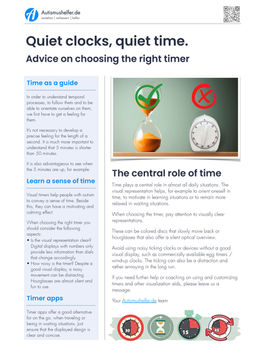Materials & tips on the subject of autism
On this page you will find a constantly growing selection of materials, forms and visual stimulations on the subject of autism and autism spectrum disorders. The download and usage is free of charge.
We are happy if our provided material makes daily interaction easier and gives you some new ideas and inspiration to redesign difficult paths..
Learning stories
Our learning stories deal with relevant autism-specific topics in a clear and age-appropriate way. They can be used as a supportive daily exercise or in preparation for upcoming events or changes. The comic strips in each of the stories can be used for a better understanding as well as for retelling them in your own words.
By clicking on an element you will get further information about the correct use. For each story we've included examples of relevant questions and transitions. Each story can be downloaded by clicking the link.
If you have any questions about the usage or if specific material is needed, please do not hesitate to contact us.

How to work with learning stories
-
Read the story or have the child read it to you
-
Read out the questions at the end of the text
-
Underline relevant information or show it in the picture
-
Optional: fill out answers in the appropriate fields
-
Retell the story together using the comic strip
-
Ask further questions to connect personal reference (Where did you go on holiday? What color is your bike? etc.)
-
Establish a better connection to current situations by asking related questions
-
Repetitions on different days improve reference and understanding and intensify preparation for possible upcoming similar events
Our learning stories
For a fullscreen view with additional tips and explanations, simply click on the different thumbnails. You can also print out or save each story by clicking the DOWNLOAD link.
Visual aids
Visual aid or stimulation often provides crucial support in the field of autism therapies. Used in different situations, it can convey clarity by depicting and repeating plans and agreements.
Not only children benefit from this kind of support. During years of working with people with various forms of autism spectrum disorders, again and again it worked out that visual representations say more than a thousand words.
This method of help is not only limited on pictograms. With autistic children and young people who can read, short written notes often help as well.
IMPORTANT: The visual design has to be clearly understandable and adapted to the respective intellectual level of the user. There are no limits to the artistic design.
From simple notes or post-its to printed cards or photos, as well as laminated schedules and magnetic boards, we have prepared and worked with it all.
Try this: Visualize recurring processes (e.g. the correct order when getting dressed, the morning routine) and see how it works.
Also answers to constantly recurring questions can be visually provided and presented at a fixed place.
We’ve put together some overviews and tips from our daily work.
Have fun browsing, tinkering and trying things out.

Advantages of visual aids
-
Contributing to a better understanding
-
Creating structure and security
-
Offering a forward-looking overview (e.g. for daily plans)
-
Having a calming effect
-
Giving possible options for behaviors (e.g. situation cards)
-
Supporting learning of specific procedures (dressing, showering, brushing teeth)
-
Can be used anywhere (at home, at school, at work)
-
Can be printed out, handcrafted or used digitally (while traveling)
-
Can be used regardless of the diagnosis of Asperger syndrome, early childhood autism or atypical autism
Materials for visual aid & everyday tips
For a fullscreen view with additional tips and explanations, simply click on the different thumbnails. You can also print out or save each story by clicking the DOWNLOAD link.
Everyday tips
In our daily work with people with autism and their families, we face a wide variety of challenges, which constantly brings new insights. Despite the individuality in the area of autism spectrum disorder, there are similar situations and correspondingly similar solutions.
We would like to share our very own pool of experiences with you and we would love to expand it with your help.
If you are a parent, teacher, therapist or affected one and you would like to share your special insights on certain autism-specific topics, please write to us.
We hope our tips and tricks will help you in your everyday life and motivate you to try out new approaches in challenging moments.
Tips for challenging situations
-
Analyze the behavior and try to find the trigger for: fear, demotivation, excessive demands etc.
-
Double check your motivation concept: What could be more motivating or be a good reward for the specific project?
-
Is there a clear visual motivation? If not, simply painted notes or a painting app on your cell phone/tablet can provide fast help
-
If possible use a clear timer to visualize the time left until the reward / end of the project
-
Reward any "desired behavior": Even during (pre) melt down situations, there are short moments of quietness; praise them profusely
-
Work out a precise visual schedule together: draw or write down the project together with individual steps
-
Discuss the process again and set the points for rewards




























